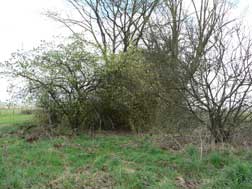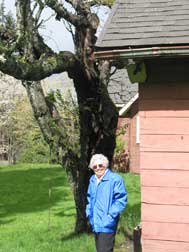Guild-Klady Centennial Farm
 Cuttings: Lady Apple
Cuttings: Lady Apple
Original Source: Guild-Klady Centennial Farm, Woodland, WA.
Uses: The family made applesauce from the apples. Some of the apples were used to make Christmas decorations.

History: Osa May Taggert’s Great Grandfather (Guild) planted them in the late 1800’s. Several had to be re-planted after the flood and severe winds of 1893. Her Grandfather purchased the property from her Grandmother’s father (Klady) in 1912. Many of the original trees and different varieties are still standing.
Goerig Site
 Cuttings: Concord Grape, Royal Anne and Bing Cherries
Cuttings: Concord Grape, Royal Anne and Bing Cherries
Original Source: Goerig Family Site, on Goerig Road, just across the railroad tracks from downtown Woodland.
History: The Goerig property, on Caples Road, was the site of the first St. Philips Church. The first catholic mass in SW Washington was held there, in 1872, the first in a non-sanctioned church. Francis N.Goerig was born in Germany and worked as a glovemaker in Vienna until he came to America in 1848. After moving to Illinois he met and married his German born wife Christine in 1852. They left for Oregon in the spring of 1853 via wagon train, arriving in the fall and lived in an area around Columbia City, OR called Germany Hill. In 1865 they moved to Woodland, WA. They continued to hold mass in their home until around the turn of the century. Rosemary Bosch, who is now 88 years old, grew up on the property, which belonged to her Grandfather. Her Grandmother used the fruit to make jelly.
Buker Homestead
 Cuttings: Greening and Gravenstein Apples
Cuttings: Greening and Gravenstein Apples
Original Source: Buker Farm near Burnt Bridge Creek and Alki Road, Vancouver, WA
History: Robert B. Buker and his Brother, Charles F. Buker  moved to the area from Colorado in 1883. Robert bought his original tract in 1883 from the widow of George J. Tooley. The Tooley land grant was signed by U.S. Grant in 1872. On December 28, 1883, Charles F. Buker became the teacher of the first school in the area and Bukers named the school Hazel Dell, a name they liked in Ohio, where Robert and Charles were born.
moved to the area from Colorado in 1883. Robert bought his original tract in 1883 from the widow of George J. Tooley. The Tooley land grant was signed by U.S. Grant in 1872. On December 28, 1883, Charles F. Buker became the teacher of the first school in the area and Bukers named the school Hazel Dell, a name they liked in Ohio, where Robert and Charles were born.
A History of the Trail Through Buker’s Farm
by Robert J. Buker
The Green Belt Trail from just below the point where Alki Road crosses Burnt Bridge Creek to the mouth of the creek was part of Walt and LaVeta Buker’s farm before the Green Belt was established. Walt’s father, Robert B. Buker, bought his original tract in 1883 from the widow of George J. Tooley. The Tooley land grant was signed by U.S. Grant in 1872.
In 1883 Robert B. Buker and his brother Charles F. Buker moved to Vancouver from Colorado where they had been gold miners. There was a gold mine at the present end of Alki road so they bought the land on both sides of the mine. They were married to sisters and their father-in-law joined them on Alki road and he built the shake house in 1883 that is still in use. Charles built his first home about 1 100 yards beyond the north end of Alki Road.
On December 28, 1883 Charles F. Buker became the teacher of the first school in the area and the Bukers named the school Hazel Dell, a name they liked in Ohio where Robert and Charles were born. Charles sold his land to his brother and moved his family to Silver Lake in Cowlitz County.
Today there are four houses on the west side of Alki road. Bukers have owned or lived in all of them plus three others that have been dismantled. Walt and LaVeta built the brick house in 1961. They lived in the shake covered house from 1935 to 1961. Before 1935 they lived in his parents house where Walt was born. This two story house was located 75 yards north of the shake covered house. I dismantled it in 1951 and found it contained some of the lumber used in Walt’s parents first house which was located under the large white fir tree that has been topped to keep it clear of the power lines. My wife and I are building our new home on the same property that my parents and grandparents built theirs.
Let me guide you on a tour of my ancestors land starting at the point where Alki Road crosses Burnt Bridge Creek. Where did the names come from? Dr. John McLaughlin, in a letter stated that from the 27th of September, 1844 a fire burned a vast amount of timber and almost burned Fort Vancouver. This creek was known as Bridge Creek before the fire, but the bridge at Fourth Plain Road burned so it became Burnt Bridge Creek. August Schaeben started Alki, an industrial area and summer resort near where Alki road intersects Hazel Dell Avenue. His 1869 vision of a suburb called “Alki”, the Indian word for by and by, looking forward, or heaven never developed. Alki is now the motto for the State of Washington. Was this the first place named Alki? There is an Alki Point in Seattle but the Vancouver name is older than Seattle’s.
Moving northwest along the trail you will come to a pear orchard that Walt Buker acquired in 1935. Not the beaver damage at the base of the first two trees. Across the creek are three long unused bull frog ponds. Before the 1929 crash this valley produced bull frog legs for Portland hotel dining rooms. The field to the south was planted to sub clover and tall fescue in 1948 and the stand is still good today.
The cattle barn was built by Walt Buker to store feed for his 35 head of Registered Black Angus beef cattle. Most of the lumber was salvaged from other barns on the farm. In 1974 Walt Buker died at the edge of the creek near the barn while looking for a new born calf. He lived all his life in this valley he loved, and he hied less than 200 yards from where he was born.
Under the power lines is a large white fir tree that has been topped to keep it below the wires. Robert B. Buker’s first house was under this tree. In the mid 1920s Walt Buker built a dam in the creek near the white fir tree. The bank along the west side of the creek was raised by shoveling soil to form a dike so that the water was higher than the field. Corn and vegetable crops were planted with the rows arranged so the water would flow by gravity all the way to the base of the hill. This productive irrigated field supported a large family as Walt was the youngest of 12 children. This dam was also the major summer recreational area for north Vancouver, a swimming hole complete with a wooden diving board.
The gold mine was located east of the white house. Bukers rented this house in the 1920s and 1930s. It was owned by the only black family in the county in the early 1900s. A vertical log religious tabernacle in the yard was the center of the religious life of some of the more affluent black families of Portland in the 1940s.
The VANCOUVER INDEPENDENT on March 20, 1879 stated that George Tooley was selling the gold mine on burnt bridge creek for $10,000. Wages were one dollar per day in 1879.
Where did the wtaer come from to run the sluice boxes near the end of Alki road? The miners dug by hand a ditch along the base of the hill extending from Cole Creek near where it crosses under Interstate 5. The ditch and the Military Road can likey still be locted below the turns on Hazel Dell Avenue. This steep hill with deep sand was a major obstacle to wagon traffic between Vancouver and Woodland at the turn of the century.
Bukers came to this valley to find gold. A few fine flakes were all that they found but they have stayed in this beautiful valley since 1883. Enjoy the Green Belt formed from the land Walt Buker tended with love. KEEP IT BEAUTIFUL. Robert J. Buker PhD Dec. 1992
St. Cloud Ranch
 Cuttings: Pacific Rose. Also, Golden Delicious, which came from a homestead immediately North of park. St Clouds White Apple, St Clouds Winesap, St Clouds Newtown/Spitzenburg cross.
Cuttings: Pacific Rose. Also, Golden Delicious, which came from a homestead immediately North of park. St Clouds White Apple, St Clouds Winesap, St Clouds Newtown/Spitzenburg cross.
Original Source: St. Cloud Ranch Homestead located in Skamania County, WA, 3 miles west of Skamania.
The apple orchard of Spitzenberg and Newtown-Pippin was planted before the turn of the century. The orchard trees provided a food source. Most were for personal use, and some were also sold at local markets.
History: The Farm was occupied by a succession of owners from 1871 and 1984. Paul J. and Florence Vial bought the property in 1909. From 1909 to the 1950s, St. Cloud Ranch was the summer home of the Vial family and boasted tennis courts, a swimming pool, boat dock and manicured grounds. Paul and Florence named their beloved home “St. Cloud Ranch” for the suburb of Paris, France where they spent their 1903 honeymoon and early married years. Today only the orchard hints of St. Cloud’s cultivated past.
Uptmor Place
Cuttings: Dolgo Crabapple – Photo Yvonne Upton
Original Source: Clark County Poor Farm (now 78th St. Experimental Station) Later cuttings were taken to the Uptmor property on N.E. 72nd St. Hazel Dell Vancouver, WA.
 History: Victor and Yvonne Uptmor moved here from Idaho in 1940. They purchased the land next to the Poor Farm in Hazel Dell. Victor collected cuttings from the farm. Cuttings from the trees were taken sometime after 1940. Age of original trees is unknown. Many of the crabapples were pickled or used for cider. Yvonne cherished the Dolgo Crab for the beauty of its blossoms and for its fruit. It was destroyed by an ice storm in winter 2004.
History: Victor and Yvonne Uptmor moved here from Idaho in 1940. They purchased the land next to the Poor Farm in Hazel Dell. Victor collected cuttings from the farm. Cuttings from the trees were taken sometime after 1940. Age of original trees is unknown. Many of the crabapples were pickled or used for cider. Yvonne cherished the Dolgo Crab for the beauty of its blossoms and for its fruit. It was destroyed by an ice storm in winter 2004.
Sam’s Walker Site
Cuttings: Bartlett Pear

Original Source: Skamania County, Columbia River Gorge
History
Heritage
Experimental
Natural Area
Heritage Orchard List